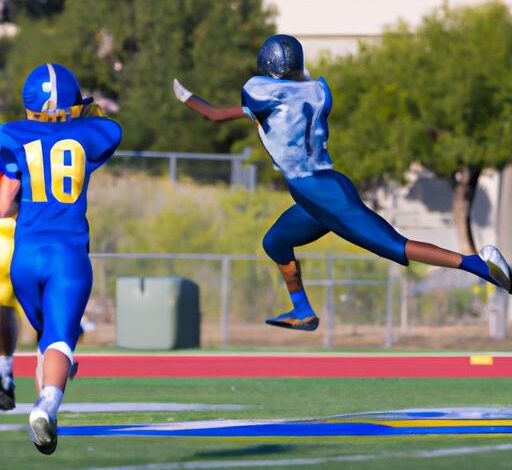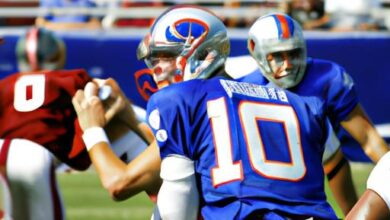What Does a Wide Receiver Do in Football?

In the exhilarating game of football, every position plays a crucial role in achieving victory. Amongst the players on the field, the wide receiver stands out as a key figure, responsible for electrifying plays and captivating fans. But what exactly does a wide receiver do in football? Let’s dive into the realm of these dynamic athletes and uncover their significance.
Definition of a Wide Receiver in Football
A wide receiver, often referred to as a “wideout,” is an offensive player positioned on the edges of the offensive line. Their primary objective is to catch passes thrown by the quarterback, advancing the ball towards the end zone. With their exceptional athleticism and strategic positioning, wide receivers make an impact by creating opportunities for their team to score.
Importance of Wide Receivers in the Game
Wide receivers are the game-changers, the ones who can turn a match on its head with their skill and agility. Their ability to catch passes not only earns points for their team but also keeps the defense on their toes, forcing them to adapt their strategies. A talented wide receiver can single-handedly alter the course of a game, making them a coveted asset for any football team.
Wide receivers are vital for offensive success. They stretch the defense with their speed, create openings for other players, and provide options for the quarterback to make accurate and effective passes. Without talented wide receivers, the offense may struggle to move the ball efficiently and put points on the scoreboard.
As we explore the responsibilities, skills, and impact of wide receivers, we will gain a deeper understanding of their integral role in the game of football. Join me as we uncover the secrets of these remarkable athletes and unravel the artistry behind their plays.
Responsibilities of a Wide Receiver
Wide receivers possess a diverse range of responsibilities that contribute to the success of their team’s offense. Let’s explore the key roles that make them an indispensable asset on the field.
Catching and Receiving Passes
At the heart of a wide receiver’s duties lies the ability to catch passes from the quarterback. This skill requires not only exceptional hand-eye coordination but also the focus and concentration to secure the ball amidst tight coverage. Wide receivers must be reliable targets, capable of making contested catches and hauling in receptions to move the offense forward.
Running Routes and Creating Separation
To maximize their effectiveness, wide receivers must master the art of running precise routes. They meticulously plan and execute their paths, using quick cuts, speed bursts, and deception to gain separation from defenders. By creating space between themselves and their opponents, wide receivers provide the quarterback with a clear target, increasing the chances of a successful completion.
Blocking for the Running Backs
While catching passes may be their most glamorous duty, wide receivers are also expected to contribute to the running game by blocking for their teammates. By engaging with defensive players and impeding their progress, wide receivers create lanes for the running backs to exploit. Their blocking skills are crucial for establishing a strong ground attack and keeping the defense guessing.
Adjusting to Different Passes and Plays
Wide receivers must possess the versatility to adapt to various passes and plays. Whether it’s a short screen pass, a deep bomb, or a slant route, they must quickly analyze the situation and adjust their positioning and speed accordingly. This adaptability allows them to exploit defensive weaknesses and capitalize on scoring opportunities.
Providing Offensive Options for the Quarterback
Wide receivers serve as valuable options for the quarterback when they’re under pressure or searching for an open target. They must be adept at finding openings in the defense, making themselves available for a pass even in chaotic situations. By offering multiple viable options, wide receivers help the offense maintain momentum and keep the defense guessing.
As we delve deeper into the world of wide receivers, we’ll explore the specific skills and qualities that enable them to excel in their roles. Join me as we unravel the secrets behind their breathtaking catches, precise routes, and game-changing contributions.
Skills and Qualities of a Wide Receiver
To excel as a wide receiver, one must possess a unique blend of skills and qualities that set them apart from the rest. Let’s explore the key attributes that make these athletes exceptional on the field.
Speed and Agility
Speed is a fundamental trait for any wide receiver. The ability to burst off the line of scrimmage and outrun defenders allows them to create separation and make explosive plays. Alongside speed, agility plays a vital role. Wide receivers must swiftly change direction, evade defenders, and navigate through traffic to find open spaces on the field.
Good Hand-Eye Coordination
Catching passes is the primary responsibility of a wide receiver, making hand-eye coordination a crucial skill. The ability to track the ball, adjust their body position, and snatch it out of the air with precision is what separates good receivers from great ones. This coordination allows them to make acrobatic catches and secure the ball even under tight coverage.
Route Running Abilities
Route running is an art form in itself. Wide receivers must be adept at running precise routes, making sharp cuts, and fooling defenders with their footwork. The ability to sell a fake or create separation through route running is essential for a receiver to get open and give the quarterback a viable passing target.
Body Control and Balance
Wide receivers often find themselves in challenging situations, whether it’s making catches in traffic or tiptoeing along the sideline. Body control and balance are critical skills that enable receivers to maintain control of their body while making difficult catches or staying inbounds. This skill ensures they can make plays in tight spaces and maintain possession of the ball.
Physicality and Strength
Although wide receivers might not be the biggest players on the field, physicality and strength are still important attributes. They need to fight off defenders, win battles for contested catches, and block effectively for their teammates. A strong wide receiver can overpower opponents, gain leverage, and gain an advantage in crucial moments.
By honing these skills and qualities, wide receivers become versatile weapons for their teams. They possess the ability to impact games with their speed, agility, coordination, route running, body control, and physicality. These attributes, combined with their innate talent and dedication, make wide receivers true assets in the realm of football.
Different Types of Wide Receivers
When it comes to wide receivers in football, it’s essential to recognize that they come in various types, each with their unique skill sets and roles on the field. Let’s take a closer look at the different types of wide receivers and how they contribute to the success of their team.
Deep Threat Wide Receivers
Deep threat wide receivers are the speed demons of the team. They possess exceptional speed, acceleration, and agility, allowing them to sprint past defenders and create explosive plays down the field. These receivers excel in running “go” routes or streaking straight down the sideline, posing a constant threat to the opposing defense. With their ability to stretch the field vertically, deep threat wide receivers force the defense to allocate extra resources to contain them, opening up opportunities for other offensive players.
Possession Wide Receivers
Possession wide receivers are the reliable targets for the quarterback. They excel in route running, possessing precise timing and exceptional hands. These receivers are skilled at finding the soft spots in the defense, making them dependable options for short and intermediate passes. Possession wide receivers use their body control and strong hands to make tough catches in traffic, often serving as a safety blanket for the quarterback in critical situations.
Slot Wide Receivers
Slot wide receivers line up between the offensive line and the wide receivers on the edges. They are often smaller in stature but compensate with quickness, agility, and exceptional route-running abilities. Slot receivers are adept at finding openings in the defense and exploiting mismatches against linebackers and safeties. Their agility and elusiveness make them difficult to cover, providing a reliable target for the quarterback in the middle of the field.
Red Zone Wide Receivers
Red zone wide receivers are the go-to targets when the offense is close to scoring. With their size, strength, and leaping ability, they excel at contested catches in the end zone. Red zone wide receivers use their physicality to outmuscle defenders and position themselves to make crucial touchdown receptions. Their presence in the red zone adds an extra dimension to the team’s offense and puts immense pressure on the opposing defense.
As we delve into the different types of wide receivers, it becomes clear that their diverse skill sets contribute to the overall success of the team. Each type brings a unique set of abilities to the field, making them essential in executing various offensive strategies. From stretching the field to providing reliable targets, wide receivers are the catalysts for explosive plays and touchdowns.
Famous Wide Receivers in Football History
When we think of legendary wide receivers in the history of football, several names immediately come to mind. These players have left an indelible mark on the sport, showcasing their immense talent, dedication, and ability to make jaw-dropping plays. Let’s take a closer look at some of the most iconic wide receivers to have graced the gridiron.
Jerry Rice
Jerry Rice, often regarded as the greatest wide receiver of all time, is a name that resonates with football enthusiasts worldwide. His illustrious career spanned two decades, during which he shattered numerous records and set new standards for the position. Rice’s impeccable route running, outstanding hands, and remarkable work ethic made him a force to be reckoned with on the field.
Randy Moss
Randy Moss, known for his electrifying speed and incredible leaping ability, revolutionized the wide receiver position. His ability to stretch the field, coupled with his exceptional catch radius, made him a nightmare for opposing defenses. Moss’s highlight-reel catches and knack for making the seemingly impossible plays earned him a place among the all-time greats.
Calvin Johnson
Calvin Johnson, also known as “Megatron,” possessed a unique combination of size, speed, and athleticism that made him virtually unstoppable. Standing at an imposing 6’5″, Johnson dominated defensive backs and consistently made acrobatic catches. His physicality and ability to outmuscle opponents established him as one of the most dominant wide receivers of his era.
Larry Fitzgerald
Larry Fitzgerald’s remarkable career has been defined by his reliability, precision route running, and exceptional hands. Known for his ability to make clutch catches in critical moments, Fitzgerald has consistently displayed his football IQ and impeccable work ethic. His consistency and longevity in the game have earned him the respect of players, coaches, and fans alike.
These wide receivers have left an indelible legacy, inspiring future generations of players to strive for greatness on the football field. Their contributions to the game have solidified their places in the annals of football history, forever etching their names amongst the sport’s elite.
Conclusion
In conclusion, the wide receiver position in football is an indispensable one, with players who possess exceptional skills and athleticism. They play a pivotal role in the offense, catching passes, running routes, and creating opportunities for their team to score. The importance of wide receivers cannot be overstated, as they stretch the defense, provide options for the quarterback, and electrify the game with their explosive plays.
Throughout football history, we have witnessed legendary wide receivers like Jerry Rice, Randy Moss, Calvin Johnson, and Larry Fitzgerald. These players have not only left an indelible mark on the sport but have also redefined the position with their remarkable abilities and performances.
Whether it’s the deep threat wide receivers who burn down the field, the possession wide receivers who move the chains, or the slot wide receivers who excel in short and quick routes, each type brings a unique set of skills to the game. Their versatility and adaptability make them a force to be reckoned with, capable of changing the momentum of a match in an instant.
As we have explored the role of wide receivers in football, we can appreciate the immense impact they have on the game. From their dynamic catches to their precise route-running, wide receivers epitomize the essence of skill, athleticism, and strategy in football.
So, the next time you watch a football game, pay close attention to the wide receivers darting across the field, making jaw-dropping catches, and leaving defenders in their wake. They are the ones who elevate the excitement, the ones who embody the spirit of the game, and the ones who truly make football a spectacle to behold.
Conclusion: So above is the What Does a Wide Receiver Do in Football? article. Hopefully with this article you can help you in life, always follow and read our good articles on the website: investment.camerahuzz.com



